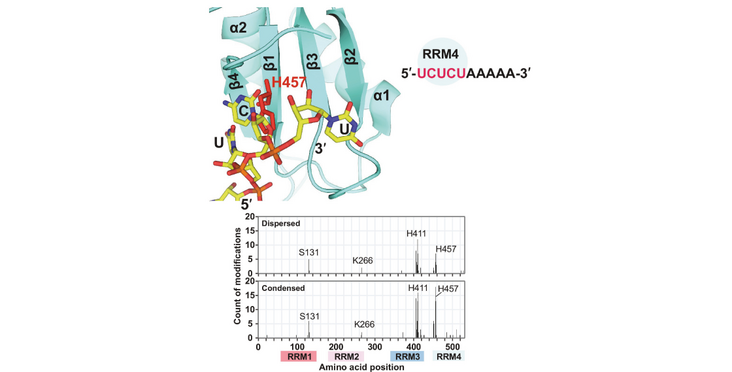In a "Science Advances" paper, the Allain (IBC) and Leitner (IMSB) groups present the extension to condensates of their mass spectrometry-based approach to study RNA-protein interactions. They find that specific interactions in the liquid phase mostly remain present in the condensed phase.
Liquid-liquid phase separation of biomolecules leads to membraneless cellular bodies, which are found to play essential roles in more and more biological processes. Also, from these condensates irreversibly insoluble aggregates may be formed which are one of the hallmarks of several neurological diseases. Many of these condensates contain RNAs and proteins, but so far, a method was lacking to obtain structural information on such complexes within condensates.
The Allain and Leitner groups extended their crosslinking mass spectrometry-?based method to study protein-RNA complexes at single residue resolution (Dorn et al, (2017) Nature Methods) to phase-separated complexes, yielding the LLPS-CLIR-MS method. Crosslinking is performed on samples containing both the soluble and condensed form of the protein-RNA complexes, which are subsequently separated by centrifugation. After sample preparation including protease and nuclease digestion, the resulting peptide-oligonucleotide conjugates are analyzed by tandem mass spectrometry and allow for comparisons of the interactions present in the two phases.
Using LLPS-CLIR-MS, they analyzed the condensates of three different RNA-protein complexes. They found that specific protein RNA interactions present in solution, remain mostly preserved in the condensates, and contribute to the phase separation phenomenon, in addition to unspecific contacts which increase in the condensed phase. Combined with data from NMR and EPR, LLPS-CLIR-MS should allow for the structure determination of phase-separated protein-RNA complexes.
Read the Publication in Science Advances (Open Access)
Figure from de Vries, Novakovic et al (2024) Sci Adv published under a CC BY 4.0 license.
